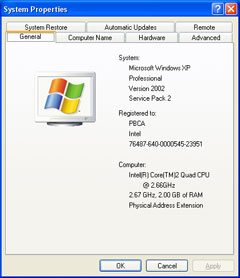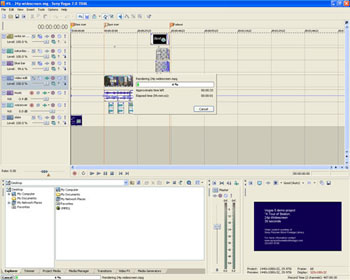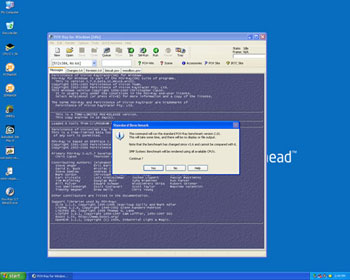
Original Link: https://www.anandtech.com/show/2092
Quad Cores: Intel Kentsfield Preview
by Anand Lal Shimpi on September 28, 2006 7:00 PM EST- Posted in
- CPUs
At this year's Spring IDF, before the launch of Intel's new Core 2 processors, in an unprecedented move (for Intel) we were allowed to benchmark the new Core 2 processor alongside an AMD system and publish benchmarks. While we've previewed Intel processors in the past before their launch, this was the first time we were able to test something this far in advance of its launch, with Intel's support, and also test a competing AMD part at Intel's own show. Previously, Intel would hardly even recognize that it had a competitor, but in the past year alone Intel's attitude towards competition has changed dramatically. The change in heart was also quite evident at this year's Fall IDF, where featuring competing AMD solutions on stage for performance comparisons was far from taboo.
Generally speaking, Intel had a lot of success with its early previews of the Core 2 processors. Readers could get a good idea of performance well before its launch and they could plan upgrades accordingly, and as it turned out, the final shipping performance of Core 2 CPUs was nothing short of impressive. With the November launch of its quad-core Kentsfield and Clovertown based processors quickly approaching, Intel offered members of the press a similar chance to take an early look at quad-core performance at IDF.
This time around there were only two systems, both of which were Intel based. There's no need for a reference AMD system since we've already determined that Intel's Core 2 Extreme processor is faster than anything AMD currently has to offer; what we're now interested in is how much of a performance improvement you can get from going to quad-core. Both systems were identically configured with 2GB of DDR2-800 running at 4-4-4-12 timings on an Intel BadAxe2 motherboard based on the 975X chipset.
 |
 |
| Click to enlarge | |
Unfortunately, we weren't very pleased with the benchmarking circumstances this time around. When we tested Core 2 at last IDF, we were able to run some of our own benchmarks and the benchmarks represented a reasonable subset of the performance tests we were already running in house. With Intel's quad-core setup, we were not able to run any of our own benchmarks and the majority of the tests we were able to run were of benchmarks we wouldn't normally use to begin with. While we could adjust settings and use some of our own demos/test configurations last time, this time we couldn't do anything other than click go and see the results generated in real time. There's no reason to believe that Intel did anything fishy, and the performance we saw agreed with internal performance testing of Kentsfield, but overall the time benchmarking at IDF was not all that useful.
Keep in mind that the benchmarks Intel selected to show off were specifically chosen to maximize the impact of four cores, and thus we're looking at a lot of significantly multi-threaded applications like 3dsmax. Realistically, the majority of tests in our normal CPU benchmark suite will not see a benefit from quad-core and thus the real purchase decision between dual and quad core is far more difficult to make than you'd think based on these numbers alone. At the same time, when your options at $999 are a 2.93GHz Core 2 Extreme X6800 (dual-core) or a 2.66GHz Core 2 Extreme QX6700, we'd generally recommend going for the latter if you're multitasking at all or plan on running any applications that are well threaded. Even games like Alan Wake and Unreal Tournament 2007 will be able to take advantage of the extra cores, and you can always overclock the processor to make up for the clock speed difference, but you can't enable more cores than you have.
With the stage set, let's take a look at the actual performance Kentsfield brings to the table.
Kentfield Performance
Updated: We initially had a flawed equation for determining percentage differences on the time-based benchmarks. When higher scores are better, it is easy to state that something is a certain percentage faster. For timed tasks, the proper terminology would be how much longer the slow machine takes, or alternately what percentage of the time it would take the faster machine to complete the same task. The percentages now represent an advantage for POV-Ray, PCMark05, and 3DMark06 CPU, while in DivX, Sony Vegas and 3dsmax 8 the percentages are how much longer the X6800 takes. Hopefully, that will help make things clear (as mud).
| DivX 6.2.5 w/ XMPEG 5.03 (encoding time in seconds) | |||
| Core 2 Extreme QX6700 (2.66GHz 2x4MB/Quad) |
Core 2 Extreme X6800 (2.93GHz 4MB/Dual) |
Percentage Disadvantage (X6800 vs. QX6700) |
Clock Scaling Estimate (Quad vs. Dual) |
| 77 | 106 | 37.7% | 51.4% |
The DivX performance test is similar to the encoding test we run for our usual CPU reviews, although Intel runs it with higher quality settings so that it stresses the CPU more. Here, the lower clocked, quad-core Core 2 Extreme QX6700 can encode the video in 72.6% of the time of the X6800, or put another way the X6800 takes 37.7% longer. Assuming linear frequency scaling, quad-cores could complete the video encoding in around 66% of the time as dual cores, or dual cores would take 51.4% longer in DivX encoding.
 |
| Click to enlarge |
| Sony Vegas 7.0a (rendering time in seconds) | |||
| Core 2 Extreme QX6700 (2.66GHz 2x4MB/Quad) |
Core 2 Extreme X6800 (2.93GHz 4MB/Dual) |
Percentage Disadvantage (X6800 vs. QX6700) |
Clock Scaling Estimate (Quad vs. Dual) |
| 252.9 | 381.6 | 50.9% | 66.0% |
Sony's Vegas application is an Adobe Premier-like application, and rendering video in it is a highly multi-threaded workload. We see that the X6800 takes 50.9% longer than the QX6700. Were we to have equal clock speeds, dual core would take around 66% longer.
 |
| Click to enlarge |
| POV-Ray Beta 15 (pixels per second) | |||
| Core 2 Extreme QX6700 (2.66GHz 2x4MB/Quad) |
Core 2 Extreme X6800 (2.93GHz 4MB/Dual) |
Percentage Advantage (QX6700 vs. X6800) |
Clock Scaling Estimate (Quad vs. Dual) |
| 2583 | 1431 | 80.5% | 98.55% |
Using the POV-Ray multi-threaded beta we ran the application's built in benchmark and noticed a tremendous increase in performance. The QX6700 is over 80% faster than the X6800 thanks to a doubling in the number of cores. Estimating performance scaling at equal clock speeds again, we should get nearly twice the performance with four cores as with two cores, a 98% performance increase.
 |
| Click to enlarge |
| 3dsmax 8 SP2 (rendering time in seconds) | |||
| Core 2 Extreme QX6700 (2.66GHz 2x4MB/Quad) |
Core 2 Extreme X6800 (2.93GHz 4MB/Dual) |
Percentage Disadvantage (X6800 vs. QX6700) |
Clock Scaling Estimate (Quad vs. Dual) |
| 49 | 80 | 63.3% | 79.6% |
The 3dsmax 8 test is simply rendering a single frame at high resolution, and the X6800 takes 63.3% longer than the QX6700. Accounting for clock speed differences, dual cores should take about 80% longer than quad cores.
| PCMark05 Professional | ||||
| . | Core 2 QX6700 (2.66GHz 2x4MB/Quad) |
Core 2 X6800 (2.93GHz 4MB/Dual) |
Percentage Advantage (QX6700 vs. X6800) |
Clock Scaling Estimate (Quad vs. Dual) |
| Overall | 7594 | 7706 | -1.5% | 8.40% |
| CPU Score | 8485 | 7406 | 14.6% | 26.03% |
PCMark05's overall score gives you more of an idea of what you can expect for workloads that aren't highly multithreaded, where there's a reduction in performance thanks to the lower clock speed. Looking at the CPU test in specific, there's an advantage to the quad-core setup but it is under 15%, much lower than some of the other workloads. At identical speeds, quad cores should still be a bit faster than dual cores in PCMark05 (8% and 26% faster respectively). This is a far more typical usage scenario for your average user than highly threaded video and 3D rendering applications, unfortunately, and in gaming tests we expect QX6700 to often be slightly slower than X6800.
| 3DMark06 CPU score | |||
| Core 2 Extreme QX6700 (2.66GHz 2x4MB/Quad) |
Core 2 Extreme X6800 (2.93GHz 4MB/Dual) |
Percentage Advantage (QX6700 vs. X6800) |
Clock Scaling Estimate (Quad vs. Dual) |
| 3906 | 2487 | 57.1% | 72.76% |
Rounding off the tests that were loaded on the system we've got 3DMark 06's CPU test, which is obviously multithreaded as is evident by the 57% increase in performance on the QX6700 processor. Were we to have a 2.93 GHz QX6800, the estimated performance would be 73% higher than dual core. Obviously most games today won't show anywhere near that sort of performance improvement due to quad-core, but if Remedy's Alan Wake is any indication of what's to come, quad-core gaming may be a reality starting as early as 2007.
Closing Thoughts
With only a 266MHz difference in clock speed, the new Core 2 Extreme QX6700 isn't too hard of a choice to make. When Intel introduces a lower cost 2.40GHz Core 2 Quad version, things may get a little more complicated, but at the very high end we would rather have four slightly slower cores than two slightly faster cores. We expect that there will be some improvements in multitasking performance, especially if you have a decently fast I/O setup, and don't forget the performance boost you'll get in well threaded applications.
The first quad-core CPUs will be available in November of this year, with more affordable offerings being introduced early next year. Building on top of the already excellent performance of Intel's Core 2 Duo processors, Intel's quad-core solutions will offer a very attractive upgrade path for those users that have invested in the right motherboards today. We're currently working on putting together a list of all currently shipping motherboards that will support Kentsfield to best help you plan for a more upgrade-friendly machine, and we will have the initial list available later today.







